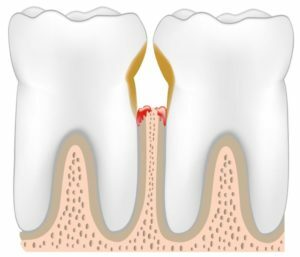 According to statistics, 90% of the population suffer from periodontitis, but they do not even suspect it. The disease itself is dangerous, as it entails severe consequences in the form of tooth loss.
According to statistics, 90% of the population suffer from periodontitis, but they do not even suspect it. The disease itself is dangerous, as it entails severe consequences in the form of tooth loss.
Today, there are many ways to treat periodontitis, but none of them can restore the state to its original form.
For this reason, it is better to perform preventive procedures in advance, which will help to avoid symptoms.
Contents
- What kind of a disease is this?
- Variety of pathology
- Causes of the disease
- Clinical picture
- Recommendations of doctors
- Surgical treatment
- Splinting of teeth
- Gingivoplasty
- Gingivectomy
- Patchwork
- Hardware treatment
- Laser periodontology
- Apparatus Vector
- Is it possible to cure periodontitis completely?
- Prevention of disease
What kind of a disease is this?
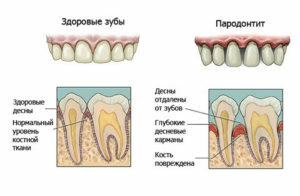 Periodontitis is an inflammatory process that locates in the peri-toothed tissues and provokes their weakening and destruction.
Periodontitis is an inflammatory process that locates in the peri-toothed tissues and provokes their weakening and destruction.
In the course of the disease, gums, cement, and alveolar processes suffer. If you do not take measures of treatment, the tissue will lose its connective properties and stop holding teeth.
Most often this problem affects people between the ages of thirty to forty years. It is also considered a crisis age from sixteen to twenty.
But this does not mean that at another age it is impossible to get sick with periodontitis, under certain conditions each person can suffer from the inflammatory process of the gums.
Species of pathology

On the photo chronic periodontitis
There are two forms of the disease, based on the duration of its course:
- Acute periodontitis is rare and otherwise is called aggressive. The disease proceeds rapidly, has pronounced symptoms and within a short time weakens the gums and destroys the teeth.
- The prolonged form of is no less dangerous, since a chronic illness will accompany the patient throughout his life. In the course of treatment, there will be periods of exacerbation and remission. The length of remission depends on what measures will be taken, but ultimately the disease will not disappear, which means that the risk of losing teeth will remain.
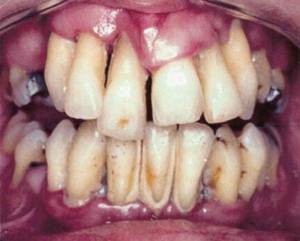
Also periodontitis is distinguished by the degree of spread in the oral cavity:
- Localized disease affects only a couple of teeth with inflammation. The lesion focus is located in one place and does not extend to other structures.
- is a more generalized form of parodontitis, in which the inflammatory process covers the entire jawbone period, usually on both jaws.
- A particularly unpleasant form is necrotizing periodontitis , which results in complete death of tissues. According to statistics, this type of disease is more common in people infected with AIDS.
In addition to the above classifications, the disease is distinguished by the degree of manifestation of the symptoms of the disease. Periodontitis can be initial, mild, moderate and severe. Let's talk about them below.
Causes of the disease
 There are many factors that can provoke the development of periodontitis:
There are many factors that can provoke the development of periodontitis:
- The most popular cause is bone tissue depletion .This happens when you often eat extremely soft foods. Only when chewing solid food from teeth and gums is naturally cleaned plaque from harmful microbes, which can cause inflammation when accumulated in tissues.
- Malnutrition of with a lack of vitamins also adversely affects the formation of bone tissue and resistance to bacteria. Particular attention should be paid to vitamin C. It has a direct effect on improving immunity, which will help to avoid periodontitis.
- Wrong sealing of or improperly installed crowns( as in the photo on the left), is also a common
 cause of periodontitis development. If you apply a seal in such a way that it protrudes above the tooth, the coating on the tissue will be preserved and promote the growth of microorganisms. In addition, a leaky sealing will allow bacteria to accumulate in the free space and destroy tissues.
cause of periodontitis development. If you apply a seal in such a way that it protrudes above the tooth, the coating on the tissue will be preserved and promote the growth of microorganisms. In addition, a leaky sealing will allow bacteria to accumulate in the free space and destroy tissues. - Incorrect bite of or low quality prostheses can damage the gums, which will cause the development of periodontitis. Gingivitis is also a catalyst for the onset of symptoms of the disease.
- It is not necessary to exclude from the possible causes of the incorrect hygiene of .Reproduction of bacteria can provoke an inflammatory process in the oral cavity, and the use of a rigid toothbrush can injure the gums.
Clinical picture of
Depending on the stage of the disease, the symptoms of periodontitis may differ:
- On the of the initial stage of the , the patient notices soft deposits on the teeth, shows bleeding gums, feels pain while eating or cleaning teeth, teeth slightly mobile. If to make a roentgen, it is possible to see the centers of destruction of a bone of an alveolar process.
- The light phase of is characterized by a more pronounced bloom on the teeth, inflamed and reddened gums in the area of contact with the teeth, and there is also bleeding of the tissues. This form of periodontitis is characterized by the appearance of gingival pockets up to 4 mm deep, in which pus can accumulate. The teeth are noticeably mobile, the roots are partially bare. X-ray shows pronounced lesion of the roots.
- The average degree of of periodontitis has more vivid symptoms than the mild stage, but an additional manifestation is deformation of the dentition, dental lamination, and their displacement. The patient feels fatigue, weakness, there is a strong susceptibility to respiratory diseases.
- The severe stage of is characterized by loss of teeth, since the roots are bare completely. Eating, especially hard food, is very painful, the gums are inflamed, pockets up to 7 mm are formed. The patient feels very bad.
Recommendations of
physicians When symptoms of a disease appear, the dentist first determines the degree of periodontal damage and only then prescribes a course of treatment. First of all, professional cleaning of the oral cavity is appointed.
 Active development of the disease occurs on the basis of improper hygiene, therefore, mechanical removal of soft plaque is used.
Active development of the disease occurs on the basis of improper hygiene, therefore, mechanical removal of soft plaque is used.
The doctor prescribes:
- rinsing course:( Maraslavin, Chlogoxydin );
- gels( Kholisal-gel, Metrogyl-denta );
- special toothpaste( Parodontax, Lakalut-asset ).
It is obligatory to carry out the sanation of the oral cavity. If there are tooth decay damaged teeth, you need to cure them. If necessary, prostheses are installed. In the late stages of prosthetics do not use, because the crown will not be fixed in the bone tissue.
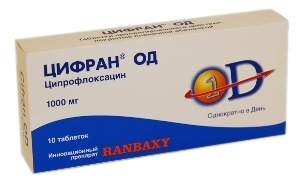 To eliminate pathogenic bacteria and reduce inflammation, antibiotics are used.
To eliminate pathogenic bacteria and reduce inflammation, antibiotics are used.
For the treatment of periodontitis, drugs are offered in tableted and injectable forms( Cyphran, Lincomycin).
Recent studies have reported that the injection of injections into the gums negatively affects the course of the disease, as the increased concentration of the drug has an adverse effect on connective tissue.
Surgical treatment
Several methods of surgical treatment of the disease are used.
Splinting teeth
As soon as the teeth become mobile, the dentist resorts to this method of treatment, such as splinting. With its help, the load is distributed from the mobile teeth to the stable ones. There are three ways of splicing:

- In the first case, when the is being sewn, a horizontal bar and fiberglass ribbon are laid on several teeth, after which everything is filled with a light composite. This crossbar strengthens the mobile teeth, stabilizing the row.
- Crowns are considered a more effective method. To do this, the upper part of the tooth is grinded, the root is sealed. From above put on crowns, welded together. The material for the crowns can be chosen depending on the preferences and financial possibilities.
- The most costly and most effective is the using the clasp prosthesis. It is put on the jaw and for additional stability it is additionally fixed by a metal crossbar.
Gingivoplasty
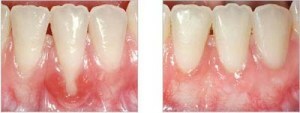
Photos before and after gingivoplasty
With periodontitis, gingivoplasty can be prescribed. It is necessary not only for aesthetic reasons, but also for cleaning and repairing pockets. The operation is performed under local anesthesia after preliminary treatment with an antiseptic.
The dentist cleans the contents of the pockets, removes dental caries and tartar from the roots, covers the tooth cement with a protective film. The gingival tissue is renewed with epithelium taken from the palatine part.
Often during gingivoplasty, bone tissue is restored or transplanted.
Gingivectomy
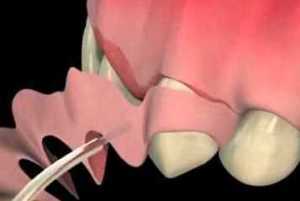 Gingivectomy is usually used in the early stages of the disease. The essence of the operation is to clean the pockets and remove the inflamed sections of the gum by cutting them. The wound is treated with a special solution and poured with iodine.
Gingivectomy is usually used in the early stages of the disease. The essence of the operation is to clean the pockets and remove the inflamed sections of the gum by cutting them. The wound is treated with a special solution and poured with iodine.
As a rule, gingivectomy is prescribed for complex operation in the area of several teeth. Often the procedure is confused with a scrappy operation.
Patchwork operation
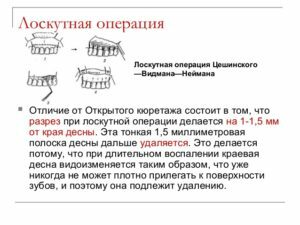 Patchwork operation can be carried out in several ways, but its main goal is to clean the roots of a dangerous plaque and secure the gums in such a way as to hide the roots as much as possible.
Patchwork operation can be carried out in several ways, but its main goal is to clean the roots of a dangerous plaque and secure the gums in such a way as to hide the roots as much as possible.
Surgical intervention is performed under local anesthesia, the dentist cuts the tissue, rehabilitates the roots and puts the scraps back. Often inflammation damaged areas of the gums are removed. Scraps of epithelium are joined by sutures.
Hardware treatment
Modern and relatively painless methods of therapy.
Laser periodontology
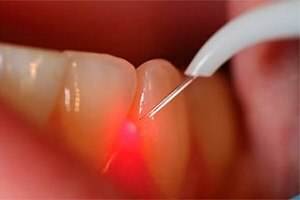 Modern treatment methods do not bypass the amazing properties of the laser. With its help, it is possible to purify the plaque with a bloodless method.
Modern treatment methods do not bypass the amazing properties of the laser. With its help, it is possible to purify the plaque with a bloodless method.
This is a much more effective method, since the mechanical effect damages the gums, which causes the periodontal disease to develop repeatedly in the affected area. Laser treatment is allowed even during pregnancy, which indicates its safety and effectiveness in the fight against periodontitis.
The laser works by means of an LED beam, which, penetrating into the pocket, has a direct effect on pathological areas, without damaging the tissue.
After using the laser, the cavity remains sterile, covered with a special protective film. This helps significantly increase the duration of remission.
Apparatus Vector
 This is another way of treating periodontitis without surgical intervention. German equipment allows for the treatment of periodontal pockets with a depth of more than 11 mm.
This is another way of treating periodontitis without surgical intervention. German equipment allows for the treatment of periodontal pockets with a depth of more than 11 mm.
The effect is due to ultraviolet radiation, which activates the work of calcium and fluorine.
The finest particles begin to move in an orderly manner, thereby removing toxins, bacteria, plaque in a natural and safe way. In addition, polishing of teeth with the help of the apparatus Vector promotes rapid healing and restoration of tissues.
Is it possible to cure periodontitis completely?
Periodontitis is a serious disease, the treatment of which is very painful. It is better to take all possible measures to avoid its manifestation, than later to fight for the preservation of teeth.
Modern methods of treatment, although significantly improved in recent years, but 100% of the disease will not get rid of.
Prevention of
 Disease Periodontitis is often caused by improper hygiene and a lack of vitamins. For this reason, it is necessary to monitor the oral cavity before and after sleep, after eating. The toothbrush should be changed every three months, while choosing medium-hard bristles.
Disease Periodontitis is often caused by improper hygiene and a lack of vitamins. For this reason, it is necessary to monitor the oral cavity before and after sleep, after eating. The toothbrush should be changed every three months, while choosing medium-hard bristles.
It is important to eat solid foods that naturally clean unwanted plaque. For this, fruits and vegetables, for example, apples and carrots, are most suitable.
Application of dietary supplements will help enrich the body with the necessary trace elements and improve immunity.
A good preventive tool is gum massage. It is enough to spend it in the morning and in the evening after hygienic procedures.
For the prevention of the disease, it is obligatory to visit the dentist twice a year for the sanation of the oral cavity. If a person has a predisposition to the disease, it is necessary, at the slightest signs, to take measures for treatment.
